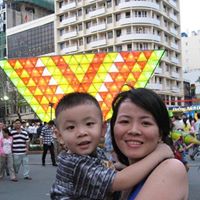Kim T Dao
age ~46
from Piedmont, CA
- Also known as:
-
- Kim Te Dao
- Kim T Bao
- Kim Tam Fok
- Kim Dao Living Tru
- Thien Dao Kim
- Phone and address:
-
68 Vernon St, Oakland, CA 94610
5104441822
Kim Dao Phones & Addresses
- 68 Vernon St, Oakland, CA 94610 • 5104441822
- Piedmont, CA
- San Francisco, CA
- Seattle, WA
- Culver City, CA
- San Jose, CA
- Bunnell, FL
Lawyers & Attorneys

Kim T. H. Dao - Lawyer
view sourceLicenses:
Texas - Eligible To Practice In Texas 1992
Education:
South Texas College of Law
Degree - Doctor of Jurisprudence/Juris Doctor (J.D.)
Graduated - 1991
Degree - Doctor of Jurisprudence/Juris Doctor (J.D.)
Graduated - 1991
Resumes

Senior Brand Manager
view sourceLocation:
95 Lexford Rd, Piedmont, CA 94611
Industry:
Consumer Goods
Work:
Clif Bar & Company
Senior Brand Manager
Clif Bar & Company Oct 2018 - Aug 2019
Direct-To-Consumer Marketing Manager
Clif Bar & Company Sep 2011 - Nov 2018
Brand Manager
Leapfrog Oct 2010 - Oct 2011
Brand Manager
Johnson & Johnson Aug 2007 - Oct 2010
Associate Product Director, Neutrogena
Senior Brand Manager
Clif Bar & Company Oct 2018 - Aug 2019
Direct-To-Consumer Marketing Manager
Clif Bar & Company Sep 2011 - Nov 2018
Brand Manager
Leapfrog Oct 2010 - Oct 2011
Brand Manager
Johnson & Johnson Aug 2007 - Oct 2010
Associate Product Director, Neutrogena
Education:
University of California, Berkeley, Haas School of Business 2005 - 2007
Master of Business Administration, Masters University of California, Los Angeles 1999 - 2001
Bachelors, Bachelor of Science, Business Economics Independence High School
Master of Business Administration, Masters University of California, Los Angeles 1999 - 2001
Bachelors, Bachelor of Science, Business Economics Independence High School
Skills:
Competitive Analysis
Consumer Products
Cross Functional Team Leadership
Customer Insight
Brand Management
Strategy
Marketing Strategy
Marketing
Business Strategy
Product Management
Marketing Research
Marketing Management
Product Marketing
Fmcg
Market Research
Management
Product Development
Strategic Planning
Leadership
Analytics
Integrated Marketing
Forecasting
Strategic Partnerships
Financial Modeling
Brand Development
Social Media Marketing
Product Launch
Financial Analysis
Sales
Merchandising
Social Media
Pricing Strategy
Consumer Package Goods
Retail
Product Innovation
Advertising
Consumer Products
Cross Functional Team Leadership
Customer Insight
Brand Management
Strategy
Marketing Strategy
Marketing
Business Strategy
Product Management
Marketing Research
Marketing Management
Product Marketing
Fmcg
Market Research
Management
Product Development
Strategic Planning
Leadership
Analytics
Integrated Marketing
Forecasting
Strategic Partnerships
Financial Modeling
Brand Development
Social Media Marketing
Product Launch
Financial Analysis
Sales
Merchandising
Social Media
Pricing Strategy
Consumer Package Goods
Retail
Product Innovation
Advertising

Kim Lang Dao
view source
Kim Dao
view source
Kim Dao
view source
Kim Phung Dao
view source
Kim Dao
view sourceLocation:
United States

Kim Dao
view sourceLocation:
United States

Vice President At Eim Insurance Services, Inc.
view sourcePosition:
Vice President at EIM Insurance Services, Inc.
Location:
San Francisco Bay Area
Industry:
Financial Services
Work:
EIM Insurance Services, Inc.
Vice President
Vice President
Name / Title
Company / Classification
Phones & Addresses
Owner, President
Dakiom
Motion Picture/Video Production · Video Production
Motion Picture/Video Production · Video Production
3056 Scott Blvd, Santa Clara, CA 95054
4087276427
4087276427
Medical Assistant
Le Dao MD Inc
Medical Doctor's Office
Medical Doctor's Office
14554 Brookhurst St, Westminster, CA 92683
Director Of Social
Mission Palms Healthcare Center
Skilled Nursing Care Facilities, Nsk
Skilled Nursing Care Facilities, Nsk
240 Hospital Cir, Westminster, CA 92683
United Faircare LLC
Internet Services, Social Networking, So · Business Services at Non-Commercial Site · Nonclassifiable Establishments
Internet Services, Social Networking, So · Business Services at Non-Commercial Site · Nonclassifiable Establishments
1559 Calle Santiago, Pleasanton, CA 94566
President
SPECTRUM ENERGETICS INC
*11 Homer Ln, Menlo Park, CA 94025
11 Homer Ln, Menlo Park, CA 94025
11 Homer Ln, Menlo Park, CA 94025
Managing
Monk Media, LLC
Internet Website · Website Onlne Magazine
Internet Website · Website Onlne Magazine
3950 Via Dolce, Venice, CA 90292
Medical Assistant
SI2 Kidscare
Nonresidential Building Operator
Nonresidential Building Operator
14554 Brookhurst St, Westminster, CA 92683
Us Patents
-
Methods And Apparatus For Stabilizing Feedback-Controlled Amplifiers
view source -
US Patent:6407633, Jun 18, 2002
-
Filed:Nov 16, 2001
-
Appl. No.:09/992507
-
Inventors:Kim Dao - Piedmont CA 94611-4326
-
International Classification:H03F 136
-
US Classification:330 86, 330282, 327554, 381121, 333174
-
Abstract:An apparatus (Z) having controllable impedance is inserted from output ( ) to ground ( ) of an audio-signal amplifier ( ). Typically, the apparatus comprises a switch-chain ( ) having multiple switches ( and so on); the first switch ( ) is connected to one terminal ( ) of the apparatus. A capacitor ( and so on) is connected from each switch to a second terminal ( ). The network formed by the switch-chain ( ) and the capacitor network ( ) is called a matrix ( C). To bypass audio frequencies away from the chopping effect of the switches, an inductor ( ) parallels the matrix. To prevent shorting of audio signals to ground, a larger capacitor ( ) is in series with the inductor. An unstable voltage at output will see increasing capacitance as more switches are closed. The changing of capacitive impedance in relation to the amplitude of the unstable voltage is designed such that the unstable voltage cannot grow too large. More complex matrices further reduce voltage fluctuations.
-
Regenerative Absorption Cycles With Multiple Stage Absorber
view source -
US Patent:51579421, Oct 27, 1992
-
Filed:Jun 14, 1991
-
Appl. No.:7/715565
-
Inventors:Kim Dao - Piedmont CA
-
International Classification:F25B 1500
-
US Classification:62476
-
Abstract:An improved regenerative absorption refrigeration cycle having a high COP and a commercially practicable pumping system. In the basic cycle, an ammonia/water solution is boiled in an externally-heated generator (11). The boiled-off ammonia vapor is cooled (14) in a regenerator (16), condensed (28), expanded to low pressure (32), and boiled in an evaporator (34) to extract heat from fluid circulating to and from a cooling load (41). The low-pressure liquid ammonia returns (46) to the regenerator (16) and is absorbed back into the low-pressure water from the generator. The solution is then cooled in a low-pressure absorber (50), pumped (53) to a high-pressure conduit (57) which is heated by the regenerator heat before going back to the generator 11. The improved cycle uses at least one intermediate absorber stage 60 to absorb more ammonia vapor (69, 71) into the solution coming from the lower pressure absorber (50) to produce a cooled solution of higher ammonia concentration. This higher concentration can be used to precool (87) the liquid refrigerant prior to expansion (32).
-
Advanced Regenerative Absorption Refrigeration Cycles
view source -
US Patent:49215159, May 1, 1990
-
Filed:Oct 20, 1988
-
Appl. No.:7/260430
-
Inventors:Kim Dao - Piedmont CA
-
International Classification:F25B 700
-
US Classification:62335
-
Abstract:Multi-effect regenerative absorption cycles which provide a high coefficient of performance (COP) at relatively high input temperatures. An absorber-coupled double-effect regenerative cycle (ADR cycle) (10) is provided having a single-effect absorption cycle (SEA cycle) (11) as a topping subcycle and a single-effect regenerative absorption cycle (1R cycle) (12) as a bottoming subcycle. The SEA cycle (11) includes a boiler (13), a condenser (21), an expansion device (28), an evaporator (31), and an absorber (40), all operatively connected together. The 1R cycle (12) includes a multistage boiler (48), a multi-stage resorber (51), a multisection regenerator (49) and also uses the condenser (21), expansion device (28) and evaporator (31) of the SEA topping subcycle (11), all operatively connected together. External heat is applied to the SEA boiler (13) for operation up to about 500 degrees F. , with most of the high pressure vapor going to the condenser (21) and evaporator (31) being generated by the regenerator (49).
-
Method And Apparatus For Recuperating Waste Heat In Absorption Systems
view source -
US Patent:52555283, Oct 26, 1993
-
Filed:Jun 3, 1992
-
Appl. No.:7/894053
-
Inventors:Kim Dao - Piedmont CA
-
International Classification:F25B 1500
-
US Classification:62101
-
Abstract:The invention relates to an absorption system having a regenerator (17) wherein an absorption process of the absorption of low-pressure ammonia vapor into a weak liquid solution of ammonia-water is carried out in the shell (16) of the regenerator (17) with the heat of absorption being used in a generation process wherein a high-pressure ammonia water solution is boiled in a conduit (14) passing through the regenerator (17). A waste heat recovery conduit (40, 40', 40") is provided for concurrent flow of an ammonia-water solution and ammonia-water vapor, the flow being heated (46) to boil the solution. The heated vapor is then introduced into the absorption process in the shell (16) of the regenerator (17) with the heat (46) used to boil the solution in the waste heat recovery conduit (40) being recuperated in the regenerator as the hot vapor is absorbed into the ammonia-water solution therein. The heat (46) used to heat the waste heat recover conduit (40) can be waste heat in the flue gas (56), or waste heat in the cool end (61) of the regenerator (17), or waste heat in the high-temperature high-pressure vapor generated in the heating conduit (14) in the regenerator and/or in the externally-heated generator (18).
-
Regenerative Absorption Cycles With Super-Pressure Boiler
view source -
US Patent:52188434, Jun 15, 1993
-
Filed:Apr 10, 1992
-
Appl. No.:7/866445
-
Inventors:Kim Dao - Piedmont CA
-
International Classification:F25B 1500
-
US Classification:62476
-
Abstract:An improved regenerative absorption cycle using a super-pressure boiler to achieve a high coefficient of performance (COP). In the basic cycle, an ammonia/water solution is boiled in high-pressure boiling conduit (66). Boiled-off high-pressure ammonia vapor is condensed (96), expanded to low-pressure (99), and boiled in evaporator (101) to extract heat from a refrigerating fluid going to cooling load (104). Low-pressure ammonia vapor from evaporator (101) returns to regenerator (28) and is absorbed back into low-pressure liquid. The low-pressure solution from regenerator (32) is then cooled in absorber (56) to reject heat from the cycle, and is then pumped (58) back to the high-pressure boiling conduit (66). In the present invention, the liquid solution from high-pressure boiling conduit (66) is pumped up to an externally-heated super-pressure boiler (11). Super-pressure ammonia vapor from boiler (11) is absorbed back into super-pressure liquid in absorption super-pressure conduit (26), which functions as an internal heat source to heat the high-pressure boiling super-pressure conduit (66).
-
Feedback Stabilization Apparatus And Methods
view source -
US Patent:6333674, Dec 25, 2001
-
Filed:Mar 15, 2001
-
Appl. No.:9/809395
-
Inventors:Kim Dao - Piedmont CA
-
International Classification:H03F 136
-
US Classification:330 86
-
Abstract:An apparatus (Z) having controllable impedance is inserted from output (22) to ground (23) of an audio-signal amplifier(20). Typically, the apparatus comprises a diode-chain (50) having multiple steps (52, 53, and so on); its first step (52) is connected to one terminal (62) of the apparatus. A capacitor (82, 84, and so on) is connected from each step to a second terminal (61). The network formed by the diode-chain (50) and the capacitor network (80) is called a matrix (60C). To bypass audio frequencies away from the chopping effect of the diodes, an inductor (31) parallels the matrix. To prevent shorting of audio signals to ground, a larger capacitor (30) is in series with the inductor. An unstable voltage at output will see increasing capacitance as it gradually breaks over more and more diodes. The changing of capacitive impedance in relation to the amplitude of the unstable voltage is designed such that the unstable voltage cannot grow too large.
-
Dc Power Supply With Compensated Current Reference
view source -
US Patent:46462201, Feb 24, 1987
-
Filed:Jun 7, 1984
-
Appl. No.:6/618219
-
Inventors:Kim Dao - Piedmont CA
-
International Classification:H02M 3315
-
US Classification:363 28
-
Abstract:A power supply 10 providing a DC output voltage comprises a voltage input circuit 11, a charge buildup and transfer circuit 14, a switch including SCR3 for selectively interconnecting the input circuit 11 and the charge buildup and transfer circuit 14, a trigger circuit including a unijunction transistor gating circuit 16 for triggering the SCR3, and a sensing circuit 22 including a current reference 26 for sensing the current output to the load 38 and comparing the output to current reference 26 while providing a comparison signal to the trigger circuit 16 so as to modify the triggering of SCR3 and thus the interconnection of the voltage input circuit 11 and the current buildup and transfer circuit 14.
Medicine Doctors

Kim V. Dao
view sourceSpecialties:
Pediatrics, General Practice
Work:
Kim V Dao MD
2360 Mckee Rd STE 4, San Jose, CA 95116
4082547400 (phone), 4082547403 (fax)
2360 Mckee Rd STE 4, San Jose, CA 95116
4082547400 (phone), 4082547403 (fax)
Education:
Medical School
Med & Pharm Univ, Ho Chi Minh City, Viet Nam (840 01 Prior 1/71)
Graduated: 1985
Med & Pharm Univ, Ho Chi Minh City, Viet Nam (840 01 Prior 1/71)
Graduated: 1985
Procedures:
Destruction of Benign/Premalignant Skin Lesions
Hearing Evaluation
Vaccine Administration
Hearing Evaluation
Vaccine Administration
Conditions:
Acute Bronchitis
Acute Conjunctivitis
Acute Upper Respiratory Tract Infections
Allergic Rhinitis
Atopic Dermatitis
Acute Conjunctivitis
Acute Upper Respiratory Tract Infections
Allergic Rhinitis
Atopic Dermatitis
Languages:
English
Vietnamese
Vietnamese
Description:
Dr. Dao graduated from the Med & Pharm Univ, Ho Chi Minh City, Viet Nam (840 01 Prior 1/71) in 1985. He works in San Jose, CA and specializes in Pediatrics and General Practice. Dr. Dao is affiliated with OConnor Hospital and Regional Medical Center Of San Jose.

Kim Van Dao
view sourceSpecialties:
General Practice
Neuromusculoskeletal Medicine, Sports Medicine
Pediatrics
Neuromusculoskeletal Medicine, Sports Medicine
Pediatrics
Education:
Faculty Mixte De Med Et De Pharm Univ De Saigon (1975) Pediatrics
Googleplus

Kim Dao
Lived:
Milpitas, CA
Fremont, CA
Berkeley, CA
Durham, NC
Los Angeles, CA
New Orleans, LA
Edmonton, AB
Fremont, CA
Berkeley, CA
Durham, NC
Los Angeles, CA
New Orleans, LA
Edmonton, AB
Work:
University of Alberta, Dept of Physical Therapy - Instructor
Education:
University of California, Berkeley - Bioengineering, Duke University - Physical Therapy

Kim Dao
Education:
University of Texas at Dallas
Tagline:
Lover of loud smiles and good food.

Kim Dao
Education:
Saint Mary's College of California - Business Administration and Economics

Kim Dao

Kim Dao

Kim Dao

Kim Dao

Kim Dao
Youtube
Classmates

Kim Dao
view sourceSchools:
Duchesne Academy Omaha NE 1997-2001
Community:
E Haas, Kristin Schlautman, Katie Laurent, Leslie Rollover, Alex Suarez, Megan Mcvoy, Linda Prima, Katie Scott, Christina Chvala, Kelly Bryant, Jeff Daly

Kim Dao
view sourceSchools:
Begley Public School Windsor Morocco 1998-2002
Community:
Easa Ahmadzai, Hongwei Liu, David Liu, Katelyn Dankoski, Omar Alfalahi, Jeff Jarrold, Jennifer Stein, Hassan Abas, Meghan Middleton, Chaouki Hamka

Kim Dao
view sourceSchools:
Chandler Community Elementary School Worcester MA 1998-2002
Community:
Irindee Martin, Marilyn Briggs, Phillip Smith, Donna Plaud, Helen Raptis, Denise Santos, Viquan Nguyen, Eryk Chamberlin, Mariam Mahmood, Loi Dao, Sara Wali, Rana Rania

Kim Dao
view sourceSchools:
Bunche International Studies Middle School St. Louis MO 1996-2000
Community:
Kathleen Edwards, Desmond Onwumere, Lisa Thomas, Ladonna Hull, Melanie Dear

Chandler Community Elemen...
view sourceGraduates:
Kim Dao (1998-2002),
Denise Santos (1983-1985),
Helen Rapti (1981-1985),
Phillip Smith (1993-1995),
Irindee Martin (1988-1991)
Denise Santos (1983-1985),
Helen Rapti (1981-1985),
Phillip Smith (1993-1995),
Irindee Martin (1988-1991)

Bunche International Stud...
view sourceGraduates:
Quentin Parker (1997-2001),
Marcia Pargo (1996-2000),
Naisha Thomas (1998-2002),
Esad Besic (1995-1999),
Kim Dao (1996-2000),
Kratos Kratos (2000-2004)
Marcia Pargo (1996-2000),
Naisha Thomas (1998-2002),
Esad Besic (1995-1999),
Kim Dao (1996-2000),
Kratos Kratos (2000-2004)

Academic Magnet School, C...
view sourceGraduates:
Hang Kim Dao (1996-1998),
Julia Cockrell (2000-2004),
John Lynch (1997-2001),
Jessica Levine (1995-1998),
Michael Bank (1998-2001)
Julia Cockrell (2000-2004),
John Lynch (1997-2001),
Jessica Levine (1995-1998),
Michael Bank (1998-2001)

Ursuline Academy, Dallas,...
view sourceGraduates:
Ann Marie Watkins (1979-1983),
Angela Miceli (1984-1988),
Kim Dao (1986-1990),
kelly briarton (1985-1989)
Angela Miceli (1984-1988),
Kim Dao (1986-1990),
kelly briarton (1985-1989)

Thien Kim Dao Hoang
view source
Kim Dao
view source
Kim Dao
view source
Kim Anh Dao
view source
Kim Lien Dao
view source
Kim Dao
view source
Angel Kim Dao
view source
Kim Vy Dao
view sourceFlickr
Plaxo

Ms. Nguyen Kim Anh Dao
view sourceHR Manager at IDEA Inc.
Get Report for Kim T Dao from Piedmont, CA, age ~46











